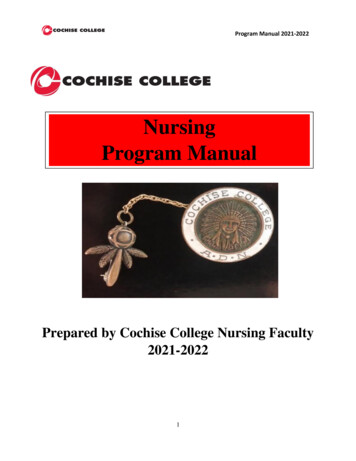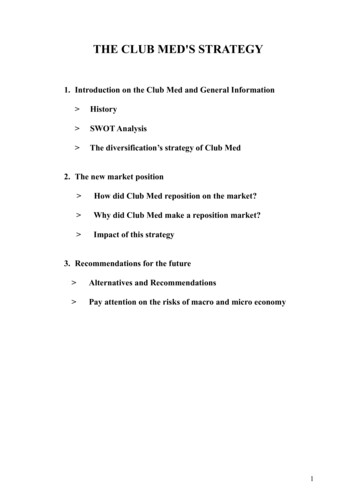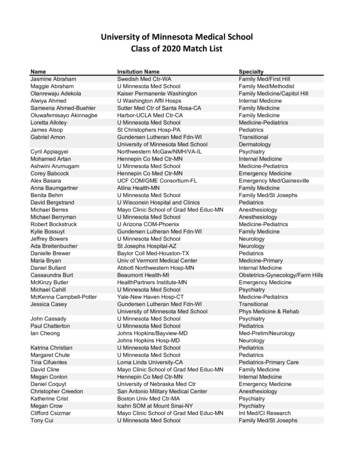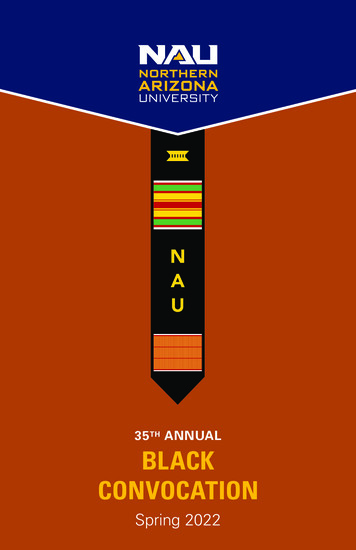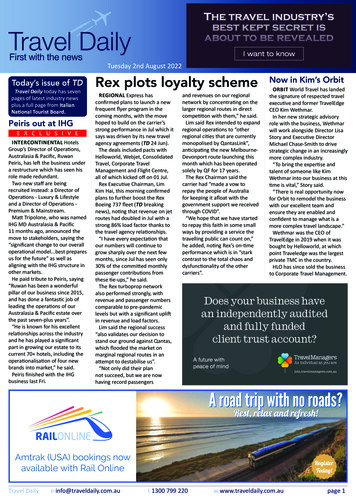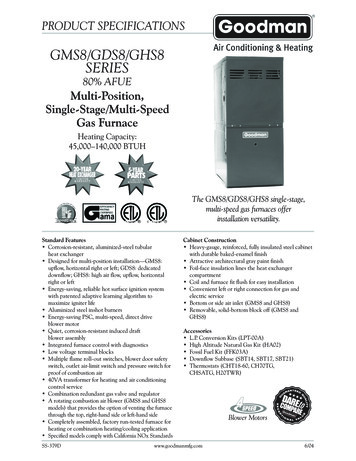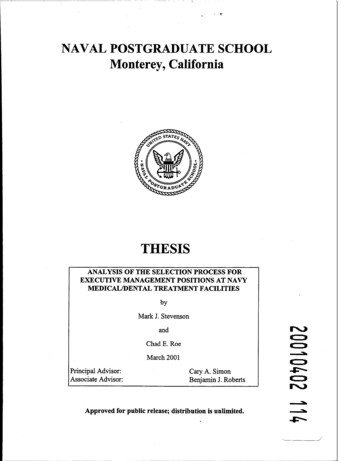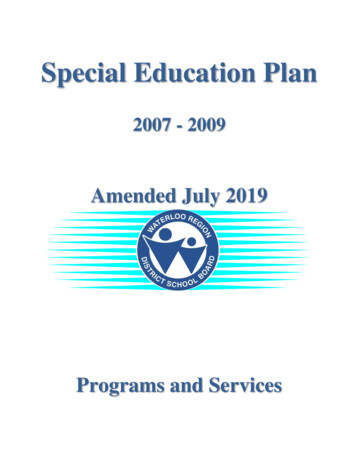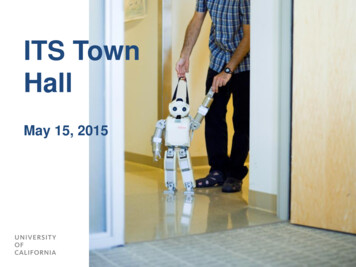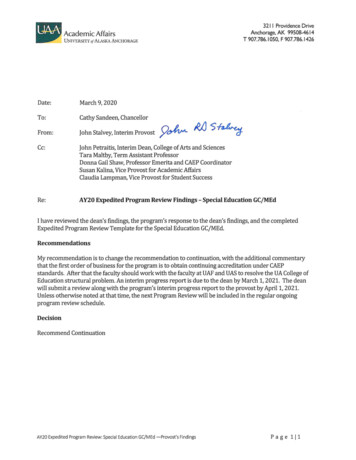
Transcription
rimAcademic Affairs U NfVERSffY oj' AL ·\SKA ANCHORAGE3211 Providence DriveAnchorage, AK 99508-4614T 907.786. I050, F907.786.1426Date:March 9, 2020To:Cathy Sandeen, ChancellorFrom:John Stalvey, Interim ProvostCc:John Petraitis, Interim Dean, College of Arts and SciencesTara Maltby, Term Assistant ProfessorDonna Gail Shaw, Professor Emerita and CAEP CoordinatorSusan Kalina, Vice Provost for Academic AffairsClaudia Lampman, Vice Provost for Student SuccessRe:AY20 Expedited Program Review Findings - Special Education GC/MEdI have reviewed the dean's findings, the program's response to the dean's findings, and the completedExpedited Program Review Template for the Special Education GC/MEd.RecommendationsMy recommendation is to change the recommendation to continuation, with the additional commentarythat the first order of business for the program is to obtain continuing accreditation under CAEPstandards. After that the faculty should work with the faculty at UAF and UAS to resolve the UA College ofEducation structural problem. An interim progress report is due to the dean by March 1, 2021. The deanwill submit a review along with the program's interim progress report to the provost by April 1, 2021.Unless otherwise noted at that time, the next Program Review will be included in the regular ongoingprogram review schedule.DecisionRecommend ContinuationAY20 Expedited Program Review: Special Education GC/MEd -Provost's FindingsPage 111
Date: 2/27/20To:John Stalvey, Interim ProvostFrom:Tara Maltby, Term Assistant ProfessorDonna Gail Shaw, Professor Emerita and CAEP CoordinatorCc:John Petraitis, Interim Dean, College of Arts and SciencesRe:AY20 Expedited Program Review: Optional Program Response to Dean’sRecommendationProgram/s in this review: Special Education GC-MEdProgram response to dean’s findings: The following statements were made by Dean Petraitis in hisclosing comments: “There are many positive things about this program, but there are two significantchallenges. First, it is housed in CAS which is faced with steeper budget cuts than any other college atUAA. The budget cuts are particularly problematic for programs – like this one – that do not cover theirinstructional costs through tuition and rely on state appropriations through CAS.” As noted earlier in the“Program Demand” section of the document, “Student credit hours and class sizes dropped in recentyears but the program consistently covers the instructional costs of the courses with the tuition that CASreceives.” Please note that the tuition that CAS receives does cover the instructional costs of the SpecialEducation programs.P a g e 1 1
Date:February 21, 2020To:John Stalvey, Interim ProvostFrom:John Petraitis, Interim Dean, College of Arts and SciencesCc:Tara Maltby, Term Assistant ProfessorDonna Gail Shaw, Professor Emerita and CAEP CoordinatorRe:AY20 Expedited Program Review FindingsProgram/s in this review:Special Education GC-MEdSpecialized accrediting agency (if applicable): National Council for the Accreditation of TeacherEducation (NCATE); currently pursuing Council for the Accreditation of Educator Preparation (CAEP);Specialty Program Review (SPA) through the Council for Exceptional Children (CEC)Campuses where the program is delivered: AnchorageMembers of the program review committee:Tara Maltby, Term Assistant ProfessorDonna Gail Shaw, Professor Emerita and CAEP CoordinatorCentrality of Program Mission and Supporting RoleUAA’s mission is to discover and disseminate knowledge through teaching, research, engagement andcreative expression. UAA is committed to serving the higher education needs of the state, itscommunities and its diverse peoples. It is also committed to instruction at multiple academic levels,success of all students regardless of their higher education goals, and service to the diverse peoples andcommunities of the state. UAA’s core themes are (1) Teaching and Learning, (2) Research, Scholarshipand Creative Activity, (3) Student Success, (4) UAA Community, and (5) Public Square. UAA valuesinternational and intercultural education, diversity of experiences and perspectives, and the diversity ofour unique location in Southcentral Alaska that comes from the Alaska Native peoples of this area.The College of Arts and Sciences CAS contributes to UAA’s mission with a suite of programs thatprovide, among other things,1. general education courses for undergraduates in CAS and other Colleges,P a g e 1 3
2. opportunities for undergraduates to pursue majors in the humanities, social sciences, naturalsciences, and the arts, and3. opportunities for faculty and students to pursue research and creative activities in CAS’sacademic disciplines,4. graduate programs for advanced studies.Given decreased enrollments across UAA and significant budget cuts to CAS, the challenge is to serveUAA’s and CAS’s missions with only 75% of the funds it had in 2018-2019. CAS’s shrinking budget isespecially challenging for programs that rely on state financial appropriations through CAS because theprograms have a gap between (a) the total costs of everything the program does and needs, and (b) thetuition CAS receives to cover those costs. This describes most programs in CAS: most rely on stateappropriates and CAS has 30% less than it had two years ago.The School of Education’s MEd and Graduate Certificate in Special Education contributes to CAS’s andUAA’s mission by preparing licensed educators for work with K12 students with special educationalneeds. Filling Alaska’s gaps for pre-K and K12 teaching positions is a priority for the University of Alaskaand its Board of Regents. The gap extends to special education services throughout Alaska. The MEdand Graduate Certificate in Special Education address that gap. The program is currently accredited bythe National Council for the Accreditation of Teacher Education (NCATE) and the Council for ExceptionalChildren (CEC). It is preparing for accreditation by the Council for the Accreditation of EducatorPreparation (CAEP.)Program Demand (including service to other programs), Efficiency, and ProductivityWith 26 students in 2019, the program’s demand is on par with other graduate programs in CAS wherethe median number of students is also 26. Student credit hours and class sizes dropped in recent yearsbut the program consistently covers the instructional costs of the courses with the tuition that CASreceives. The number of awards also dropped from a high of 37 in 2013 to 15 in 2019, a decrease thatparalleled a drop in the number of faculty in the program. It should be noted that 15 degrees in 2019 –although low for this program – is 50% higher than the median for CAS’s graduate programs. Overall,this program is efficient and productive.Program Quality, Improvement and Student SuccessThe program is nationally accredited, attesting to the quality of the program’s documentation, evidence,and outcomes. The entire program is offered online, allowing teachers from across Alaska to train inwork with students who have special educational needs.Program Duplication / DistinctivenessAs the faculty stated in their report, there are numerous programs in the UA system that providegraduate-level training in special education, including a UAF post-baccalaureate certificate, a UAF MEd, aUAS graduate certificate, a UAS MAT, and a UAS MEd. The case is proposed that the need for graduatelevel practitioners in special education across the state is strong enough that the duplication and overlapis justified.Commendations and RecommendationsThe faculty who wrote the report are commended for plugging holes among the tenured and tenuretrack faculty at UAA who cover special education. They have kept the program strong and are workingwell toward CAEP accreditation. They are commended for that work and the strong report theysubmitted.DecisionContinued review.P a g e 2 3
There are many positive things about this program, but there are two significant challenges. First, it ishoused in CAS which is faced with steeper budget cuts than any other college at UAA. The budget cutsare particularly problematic for programs – like this one – that do not cover their instructional coststhrough tuition and rely on state appropriations through CAS. Moreover, accredited education programsrequire considerable faculty and staff time, and therefore, financial assistance and expertise from acollege office that is best found in a College of Education. Second, the uncertainty surrounding theadministration of teacher preparation programs in the University of Alaska system makes it hard toknow about the administrative future of this program. Therefore, I recommend that this program bereviewed again in 2021 to see if CAS has enough state appropriations to retain the program and wherethe program will stand relative to the Alaska College of Education.P a g e 3 3
AY20 Expedited Program Review TemplateUpdated 2-5-2020Submission date: 2/7/2020Program/s in this review: Special Education GC and M.Ed.Specialized accrediting agency (if applicable): National Council for the Accreditation of Teacher Education (NCATE);currently pursuing Council for the Accreditation of Educator Preparation (CAEP); Specialty Program Review (SPA)through the Council for Exceptional Children (CEC)Campuses where the program is delivered:AnchorageMembers of the program review committee:Tara Maltby, Term Assistant Professor, Anchorage CampusDonna Gail Shaw, Professor Emerita and Interim Accreditation Coordinator, Anchorage Campus1.Centrality of Program Mission and Supporting Role (700 words or less)Special Education teacher preparation has been a part of education at UAA for over 45 years, with the M.Ed. inEducation, Emphasis in Special Education, included in the 1974-75 catalog. The current M.Ed. and GraduateCertificate (GC) in Special Education contribute to UAA’s core theme of “Teaching and Learning” in that theyprepare students for high-demand jobs in Alaska. The special education teacher shortage in Alaska and nationwideis well documented. According to the U.S. Department of Education Teacher Shortage Areas (TSA) NationwideListing, from 1995 to 2017, special education was an area of teacher shortage in Alaska with few exceptions*.Approximately 20,000 children and youth in Alaska (7 million nationwide) receive special education services underthe Individuals with Disabilities Education Act. Unfortunately, the Alaska Teacher Placement website documentsalmost 60 open special education positions in December 2019, halfway through the school year. The need anddemand are great.In response to the special education teacher shortage within Alaska, the Department of Education and EarlyDevelopment (DEED) created the Special Education Alternate Program Certificate. The program allows an educatorwho currently holds a valid Alaska teaching certificate with nine credits of special education coursework (instead ofthe 25-credit endorsement typically required) to be hired by a school district to teach in a special educationclassroom if no certified special education teacher applied for the open position. Teachers hired under the SpecialEducation Alternate Program Certification must enroll in a higher education program that leads to an endorsementin special education. DEED’s program allows for mutually beneficial school district/School of Educationpartnerships.The UAA Special Education program maintains a close partnership with the Anchorage School District to coordinatewith the General Education to Special Education (GETS) Scholarship program for applicants (80% of tuition isreimbursed for enrollment toward special education certification). Anchorage School District employs generaleducation teachers for special education positions utilizing the Special Education Alternate Program Certificate andsupports the teachers as they pursue an endorsement in special education via the GETS program. Many of thestudents who have completed or are currently enrolled in the M.Ed. in Special Education program have been GETSteachers. The UAA Special Education program works with other school districts across the state that use theAnchorage GETS program as a model to fill special education teaching positions. Alaska school districts currentlyworking with UAA and using the GETS program as a model include Matanuska-Susitna, Kodiak, and Valdez.*No TSA report was submitted by Alaska from 2000 to 2004. In 2005 Alaska reported no TSAs.Source: U.S. Department of Education Office of Postsecondary. (2017).Teacher Shortage Areas Nationwide Listing 1990–1991 through 2017-2018. achershortageareasreport201718.pdfP a g e 1 7
AY20 Expedited Program Review TemplateUpdated 2-5-20202.Program Demand (including service to other programs), Efficiency, and Productivity (7 year trend; 1400 words orless)The IR website generates data tables used to examine program demand, efficiency, and productivity. Each datapoint is reviewed and analyzed below.a. Data Point: Seven year degree and/or certificate awards trend.Over the seven-year period there has been a 59% decrease in the number of degrees/certificates awarded inSpecial Education. The downward trend is consistent with that experienced by CAS and SOE. But, the decrease inSpecial Education awards is larger than that recorded by the SOE (41.4%) as a whole and CAS (35%; w/o School ofEducation Awards). The largest drop in SPED awards occurred between 2013 and 2015 (46%). Since that time thenumber of awards granted has been much more stable, with an average of 16 degrees awarded each yearbetween 2016 and 2019. We suspect the decline in awards between 2013 and 2015 may have been due to the lackof stability and inconsistency in faculty appointments. In Spring 2013 there were 3 tenure-track faculty teachingcourses in Special Education. By Spring 2015 none of these 3 faculty were at UAA and there was one new, tenuretrack faculty member. This faculty member left after approximately one year and no tenure-track faculty havebeen hired in Special Education since that time. It is quite amazing that the average number of degrees awardedeach year since 2016 has remained stable. (CAS data were determined by selecting Master and Lic/Post Cert underthe Award Level tab, then selecting all CAS majors, e.g., Anthropology, Psychology, under the Major tab.)b. Data Point: Credits Per Degree (Average Credits Earned)The M.Ed. in SPED requires 36 credits. The average credits/degree over the seven-year period was 25. The GCrequires 25-26 credits. The average credits/degree over the seven-year period was 26. These data indicate thatstudents progress through the program in an efficient manner and do not take more credits than the programrequires.c. Data Point: Seven year majors or program enrollment trendThe M.Ed. and GC (combined) experienced a 59% decrease in enrollment in the seven-year period. During thesame period the SOE experienced a 31% decrease in enrollment. This decline follows the trend of the school, butnot the trend of the CAS, which experienced a 3% increase (excluding SOE data).The largest drop in SPED enrollment occurred between the years 2013 and 2015 (48%). See the comment aboutinstability and inconsistency with regard to faculty appointments under data point: Seven year degree and/orcertificate awards trend. While the enrollment in the M.Ed. continued to drop from 2016 to 2019, the enrollmentsin the GC program remained stable with an average of 21 students enrolled.For data points d through l, we were unable to duplicate the data provided to us in the original data tables fromthe IR site, so we generated and analyzed data for the following EDSE courses: EDSE A610, 612, 622, 623, 624, 625,632, 633, 634, 635, 670, 695D, 695E, 695S, and 697. (Any EDSE course ending in Y was not used because thesecourses are associated with the M.Ed. in Early Childhood Special Education, which has suspended admissions andthere are no longer any SOE faculty responsible for this program.)d. Data Point: Course pass ratesThe course pass rate is high, with an average pass rate of 92.1%. This is consistent with most non-science basedgraduate courses at UAA. The failure rate averages 4.3% over the seven-year period. This falls within the normalrange of most graduate courses at UAA. These data appear to demonstrate that both faculty and students strivefor excellence.e. Data Point: Internal demandThe data show that 278 students outside of the UAA Special Education degree programs benefitted from takingour courses. These students represented 20 different majors. Nearly 1/4th (24%) of the SCH earned in 600-levelspecial education courses were generated by students outside of the major. The data demonstrate the importanceof special education coursework to students outside the major.P a g e 2 7
AY20 Expedited Program Review TemplateUpdated 2-5-2020f. Data Point: Seven year Student Credit Hour (SCH) production trendThe data show a downward trend in SCH production. The largest decrease occurred between 2013 and 2016(53%). See data point “Seven year degree and/or certificate awards trend” for a description of this unique periodof time in the history of the program. From 2016 to 2019 there was a 17% drop in SCH production. A slight increaseoccurred in 2017 and 2018 as compared to 2016, but it was followed by a drop in 2019. The decrease in SCHproduction is consistent with decreased enrollment.g. Data Point: SCH/FTEFDespite a slight decrease (7%) in SCH/FTE over the seven-year period, the Special Education Graduate Programsare more productive than most CAS and SOE graduate programs when comparing SCH/FTE faculty and total SCH byprogram. The IR site creates a scatter plot of CAS courses (SCH per FTEF and Total SCH by Subject), with “SCH withAudit” on the y-axis and “SCH/FTEF” on the x-axis. Special education courses are positioned relatively high on they-axis. The plot illustrates that special education SCH productivity is higher than all but one non-SOE, CAS subjectarea. Special education is also positioned slightly over the halfway point on the x-axis. The plot illustrates SCH/FTEFproductivity exceeds all but one non-SOE, CAS subject area.h. Data Point: Enrollment/Full Time Equivalent Faculty (FTEF)The Enrollment/FTEF in CAS (excluding SOE programs) is fairly stable over the seven-year period. Special Educationprograms, however, experienced a 9% decrease from 2013 to 2019. But, Enrollment/FTEF in Special Education isconsistently higher than the average CAS Enrollment/FTEF every year in the last seven-year period. For example, in2019 CAS (excluding SOE programs) had an Enrollment/FTEF of 42.5 while Special Education had anEnrollment/FTEF of 85.3. Instructional productivity is two times higher in Special Education in terms ofEnrollment/FTEF as compared to an average of the non-SOE, CAS programs.(Method for acquiring CAS comparison data: Select CAS, exclude all SOE subjects, select 600-699 level.)i. Data Point: FTES/FTEFIR data show a very slight downward trend in FTES/FTEF in the Special Education programs. CAS graduateprograms data (excluding SOE) show a slight increase. But, the number of FTES/FTEF is consistently higher inSpecial Education graduate programs than in the average FTES/FTEF of CAS graduate programs. For example, in2019 CAS (excluding SOE programs) had an FTES/FTEF of 5.3 while Special Education had an FTES/FTEF of 11.2.Instructional productivity is about two times higher in Special Education in terms of FTES/FTEF as compared to anaverage of the non-SOE, CAS programs.(Method for acquiring CAS comparison data: Select CAS, exclude all SOE subjects, select 600-699 level.)j. Data Point: Class Size (Average Class Size)There is a downward trend in class size for Special Education programs and CAS graduate programs as a whole,with exceptions in 2017 and 2018 where the average class size for Special Education was larger than any other yearin the seven-year period. The average class size in Special Education Programs is consistently larger than theaverage class size in CAS graduate programs in each of the seven years analyzed. CAS (excluding SOE) has anaverage class size of 4.74 for the seven-year period as compared to Special Education’s average class size of 9.4.(Method for acquiring CAS comparison data: Select CAS, exclude all SOE subjects, select 600-699 level.)k. Data Point: Cost/SCHFrom 2015 to 2019 there was a 12% increase in Cost/SCH for Special Education programs. In terms of the cost ofSCH, however, Special Education is well below the average of CAS. The average Cost/SCH in 2019 for CAS (1258.8)is more than 4 times higher than the average Cost/SCH for Special Education graduate programs (307.4).(Method for acquiring CAS comparison data: Select CAS, exclude all SOE subjects, select 600-699 level.)l. Data Point: Tuition Revenue/SCHThe Tuition Revenue/SCH for the Special Education programs is consistent with the trends and amount for the CASas a whole. The Tuition Revenue/SCH generated in Special Education more than covers the instructional costs ofP a g e 3 7
AY20 Expedited Program Review TemplateUpdated 2-5-2020the programs. This statement cannot be made for CAS graduate programs as a whole. Excluding SOE programs, theinstructional costs of CAS graduate programs substantially exceed tuition generated.m. Data Point: External DemandThere are no “Post UAA Award NSC Data” for this program. Refer to “Centrality of Program Mission and SupportingRole” for information related to external demand.3.Program Quality, Improvement and Student Success (1500 words or less)Specialized Accreditation Process and StatusSince 2005 the School of Education advanced-level programs have maintained continuous accreditation under thestandards of the National Council for Accreditation of Teacher Education (NCATE). As a part of the nationalaccreditation process, the GC in Special Education is nationally recognized through 2023 by the Council forExceptional Children (CEC). The School of Education is currently pursuing accreditation for advanced-levelprograms from the Council for the Accreditation of Educator Preparation (CAEP). A virtual site visit is scheduled inthe Spring semester of 2021.Currency of the CurriculumIn 2017 - 2018 the faculty engaged in a substantial curriculum revision of the GC and M.Ed. in Special Education.Implementation of the new curriculum began in Fall 2018. The curriculum revisions were made in response tostakeholder feedback, assessment data indicating the need to increase field-based experiences in course work, andupdates required to better align key assessments with the CEC Professional Standards. The curriculum revision wasapproved through the UAA Curriculum approval processes.In Fall 2019 faculty met with stakeholders to review program data and to identify general areas of need in specialeducation across the state. One area of need identified by stakeholders was the importance of preparing newspecial educators, especially those who will be teaching in rural Alaska, to respond to a variety of exceptionalneeds and behaviors in K-12 classrooms. In an effort to bridge the identified training gap, an SOE faculty membermet with two members of the UAA Psychology Department to explore the possibility of using an existingpsychology course in Applied Behavior Analysis as a requirement in the Special Education programs. This additionwould provide students with a strong foundation in the basics of behavior management enhancing their ability tosupport the needs of a diverse population of learners, and distinguish UAA’s Special Education programs from thesimilar programs at UAF and UAS. Discussions with CAS are ongoing as CAEP accreditation is being pursued.Innovative Program DesignThe GC in Special Education is designed for certificated general education teachers who want to become specialeducation teachers. This program expands teaching competencies by providing the theory, knowledge, andpractical experience in special education needed to effectively serve children with disabilities and their families. Itprovides on-the-job support to teachers as they transition to becoming special educators. The M.Ed. in SpecialEducation is designed for individuals who desire advanced professional preparation in special education. Theprogram encompasses theory, research, and practice pertaining to individuals who experience disabilities. Theprogram provides candidates with the knowledge and application of assessment and intervention strategies thatsupport the learning of children with exceptional learning needs for grades K-8 (Elementary) and/or grades 7-12(Secondary) and aims to prepare scholarly practitioners grounded in purpose and research. The coursework ineach program focuses on evidence-based practices and embraces culturally-sensitive practices.Availability and Indications of Quality of Distance OfferingsSpecial education has a long, rich history in distance education, beginning with videotaped lectures mailed tostudents in the 80s and advancing to the use of modern technologies today. It was the first education program atUAA delivered completely by distance technologies. Both the GC and M.Ed. programs are offered via distancedelivery in order to be accessible statewide, and classes are offered in the evening to accommodate workingstudents. Historically, approximately 90% of the students hold full-time teaching jobs while in the program, so theyare working toward the degree as part of an employer agreement. This approach to program design and deliveryP a g e 4 7
AY20 Expedited Program Review TemplateUpdated 2-5-2020aligns with the University of Alaska Anchorage mission to serve the needs of the state, communities, and diversepeoples. It also encompasses the School of Education’s Core Values of Intellectual Vitality, Collaborative Spirit,Inclusiveness and Equity, and Leadership by preparing high-quality personnel who will be responsive to andinclusive of the diverse needs of Alaska’s learners, families, and communities.Program Student Learning Outcomes:The Academic Assessment Plan for the M.Ed. in Special Education and the GC in Special Education wassubstantially revised in May 2017. The mission of the programs is to prepare educators and support the lifelonglearning of special education professionals to embrace diversity and to be intellectually and ethically strong,resilient, and passionate in their work with Alaska's learners, families, and communities.The GC program utilizes seven key assessments, six of which are incorporated into five courses. One assessment isa nationally normed exam of content knowledge and is not based in a course. The key assessments are used tomeasure the candidate’s mastery of the Council for Exceptional Children (CEC) Professional Standards and the UAASchool of Education Student Learning Outcomes. This program is nationally recognized by CEC. As required by CEC,the assessments measure the candidate’s content knowledge in special education, ability to plan instruction,performance in clinical experience, and affect on K-12 student learning. The course-based assessments are scoredusing rubrics that are aligned with the national standards. Faculty analyze the data to help them improve coursesand experiences.Key Findings, Actions Taken to Improve Student Learning, and Evidence That These Actions are WorkingA complete reporting of key assessment data findings, analysis of data, and actions taken to improve learning can befound for each of the seven key assessments in the UAA Annual Assessment Report for Special Education programs.Following are selected findings.A. Highlights of Key Findings1. All of our graduates pass nationally normed content area exams required by the Alaska Department of Education andEarly Development for professional licensure.2. Students show a particular strength in the ability to plan instruction for K-12 students with special needs.3. In the culminating clinical experience, students demonstrate that they have met all CEC standards.B. Areas for Improvement and actions taken to improve student learning of special education majors1. Area for Improvement: Data collection on some key assessments is inconsistent.Action taken: In Fall 2019 the School of Education implemented a new student data management system (VIA byWatermark) for collecting and analyzing key assessment data. This will ensure that data for all students are consistentlycollected, stored, and analyzed even with faculty turnover.2. Area for Improvement: One key assessment in the course on mathematics for special learners indicates a need tomodify the course instruction and assignment to better prepare graduates to understand how language, culture, andfamily influence K-12 student learning in mathematics.Action taken: The Special Education program lead revised the course assignment and rubric, and then met with theadjunct faculty responsible for teaching the course to discuss adding an emphasis in this area through lectures andreadings.C. Evidence that actions are workingAlumni and employer survey data provide evidence that past actions taken based on the key findings related to programlearning outcomes are working. The most recent survey of 2017-18 special education graduates and their employersconducted by ISER include the following highlights.1. All (100%) of the special educator employers responding to the survey indicated that they are satisfied with thepreparation of UAA’s special education graduates.2. The surveys asked employers to rate 11 attributes expected of our program graduates. All employers responding to thesurvey agree that the educator (UAA special education graduate) exhibited the attributes.P a g e 5 7
AY20 Expedited Program Review TemplateUpdated 2-5-2020Student Success: High Impact PracticesStudents in the GC and M.Ed. in Special Education programs engage with a variety of high-impact practicesthroughout the program. Students have a common intellectual experience as
Donna Gail Shaw, Professor Emerita and CAEP Coordinator Susan Kalina, Vice Provost for Academic Affairs Claudia Lampman, Vice Provost for Student Success : Re: AY20 Expedited Program Review Findings -Special Education GC/MEd I have reviewed the dean's findings, the program's response to the dean's findings, and the completed

